Description of types and varieties of chlorophytum
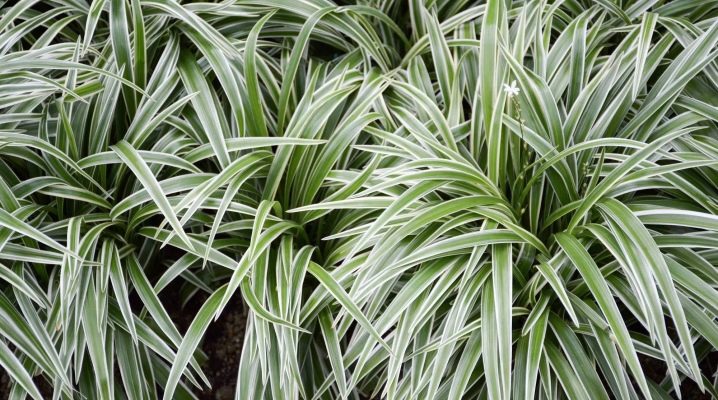
It is difficult to find a better known home flower than chlorophytum. In the 60-70s of the XX century, it was so popular in our country that it was found in almost every apartment. And until now, they are actively landscaping schools, kindergartens, hospitals and other institutions, because in addition to excellent decorative qualities, it is one of the most unpretentious indoor plants. Even novice growers can grow chlorophytum.
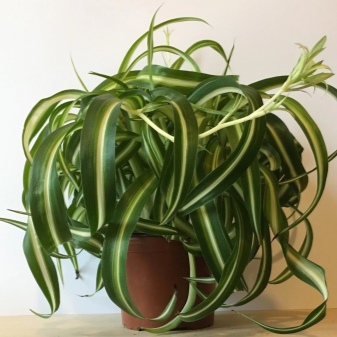
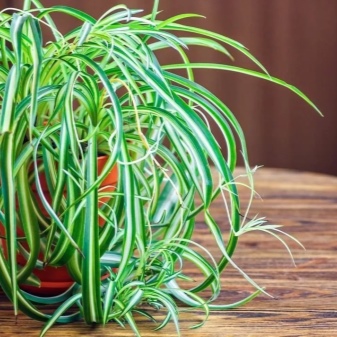
Peculiarities
Chlorophytum is native to South Africa, it is an epiphyte, that is, it grows on the trunks of other trees. Chlorophytum has no real roots - only rhizomes, in which it actively stores moisture. Therefore, it tolerates long dry periods and the lack of regular watering well.
Chlorophytum has narrow, long, light green leaf plates, sometimes with white or yellow stripes. The bush is low, up to 60 cm in diameter. With proper watering and favorable conditions, soon after planting, numerous air whiskers begin to hang from the pot. At their ends, new leaf rosettes appear, which are called "babies". With their help, the flower multiplies, and also more intensively evaporates excess moisture. Over time, new whiskers leave the "kids", and this is how green cascades are formed, for which this plant is so appreciated.
Chlorophytum flowers are inconspicuous - small, solitary, white, with bright yellow stamens.

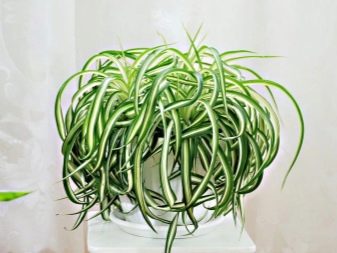
Varieties
In total, there are about 200 types of chlorophytum in nature. Their names usually reflect the characteristics of their leaf plates.
- Crested or komosum. The most famous type of chlorophytum, with long and narrow emerald leaves. In the center of each leaf plate there is one bright white wide strip or several narrow stripes. When a flower releases an arrow of 80-100 cm, 5-7 white flowers appear on it. After their flowering, a "baby" appears at the end of the air mustache.

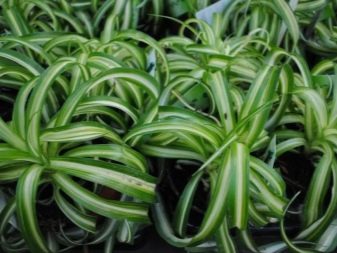
- Curly (Bonnie). In this variety of chlorophytum, the leaves reach 60 cm in length and no more than 3 cm in width. Leaves form dense basal rosettes, from which short numerous flower stalks are produced. This species does not form long air whiskers with "children", therefore, its reproduction occurs due to the division of the mother bush.
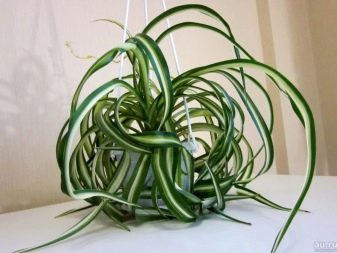
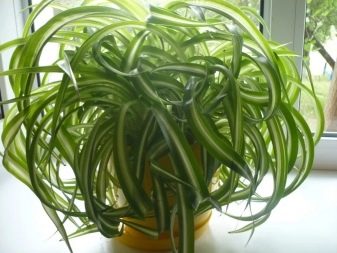
- Kapsky. This variety looks very much like curly chlorophytum, but its leaves are much longer - from 90 to 100 cm. But, like Bonnie, it does not produce peduncles and does not form "children". Reproduction takes place by dividing the mother bush.
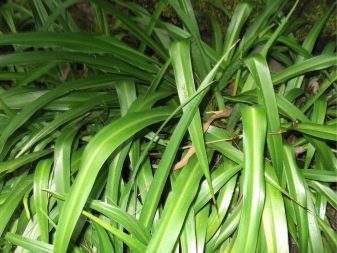

- Winged or orange (orchidostellar). Only an experienced florist recognizes chlorophytum in this plant, since it is completely different from related species. Its leaf plates are wide, elliptical, pointed at the ends. It reaches a height of 30-40 cm. The leafy petioles are fleshy, bright orange in color, which is why this species got its name. The central vein is also orange in color, as well as the warp of leaf blades in young leaves. Over time, the leaves, with the exception of the central part, become completely green. Peduncles are short, flowers are collected in inflorescences, resembling an ear. "Babies" are formed at the base of the mother bush.
In order for the flower to always retain its rich orange color, you should cut off the extra “babies” and peduncles for which the plant consumes water and nutrients.
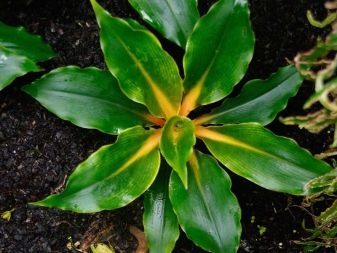
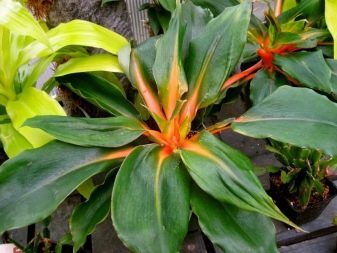
- Variegated... This variety is bred by breeders.It is distinguished by leaves with stripes of white, yellow and cream tones. Forms a long, airy mustache with "kids".
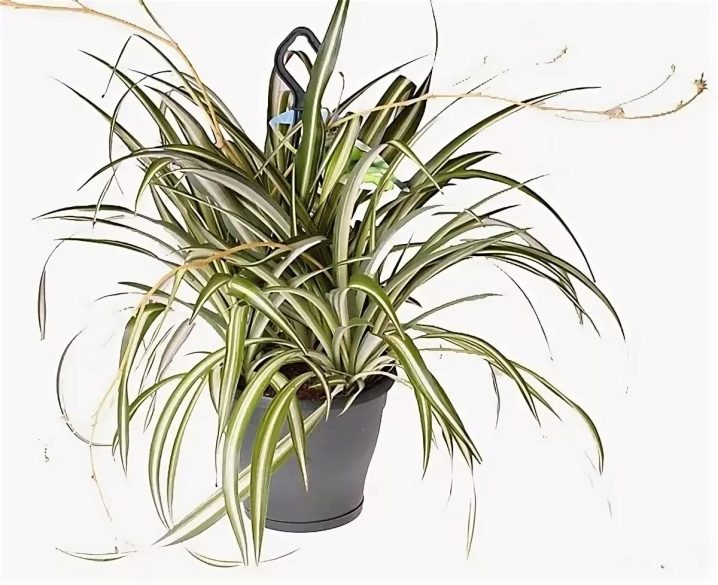
- Laxum... The most rare type of chlorophytum. Forms a dense basal leaf rosette, but does not form an airy whisker. Unlike other species, it reproduces well by seeds. The leaves are narrow - no more than 1.5 cm, framed along the edges with white stripes.
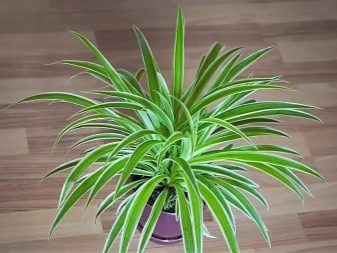
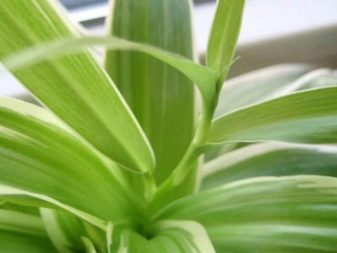
New varieties
Relatively recently, breeders have bred new varieties of crested chlorophytum, which are very popular among florists:
- Variegatum - this variety has lighter stripes along the edges of each leaf;
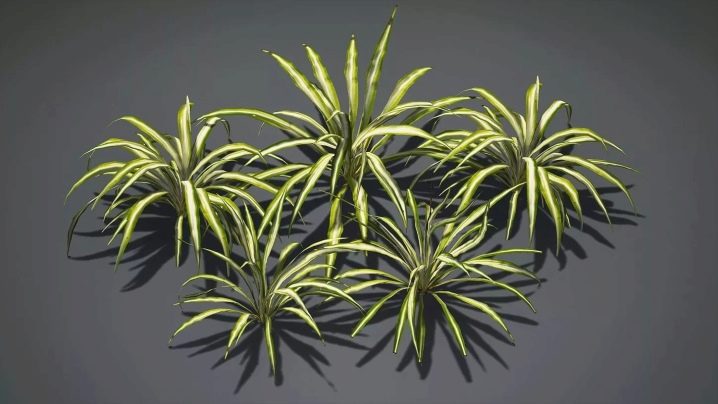
- Vittatum - this chlorophytum is distinguished by a white stripe in the center of the leaf;
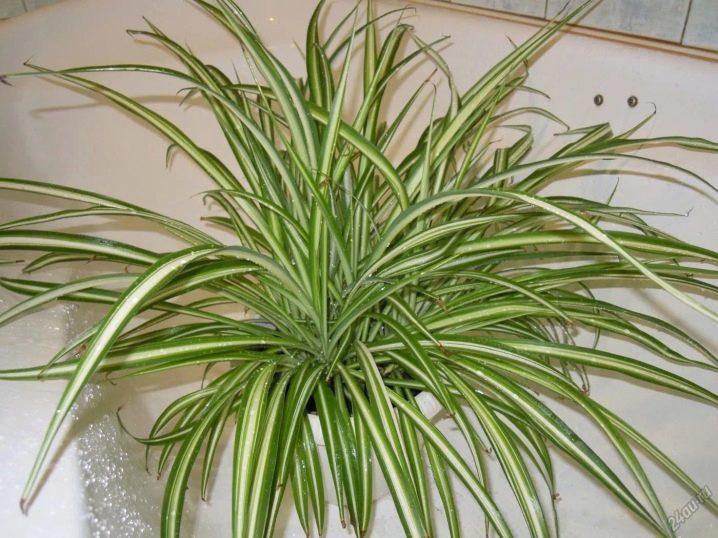
- Mboyeti - this variety is characterized by a dark emerald color of leaves with wavy edges;
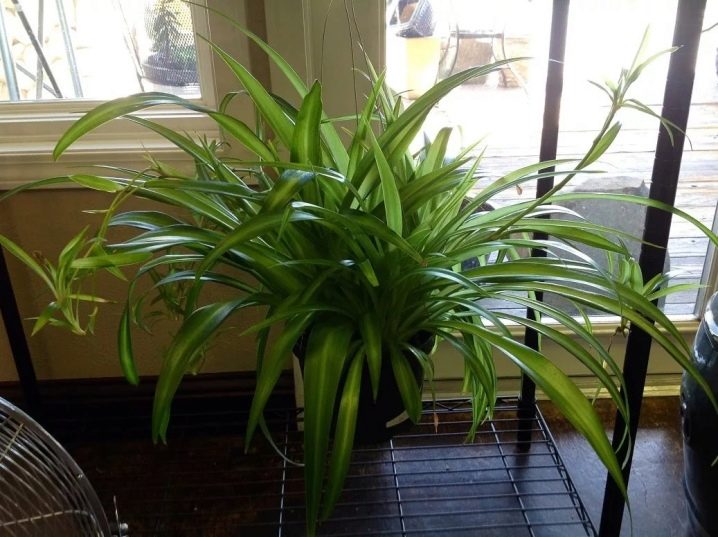
- Atlantic - this variety has thin, delicate, slightly curly leaves;
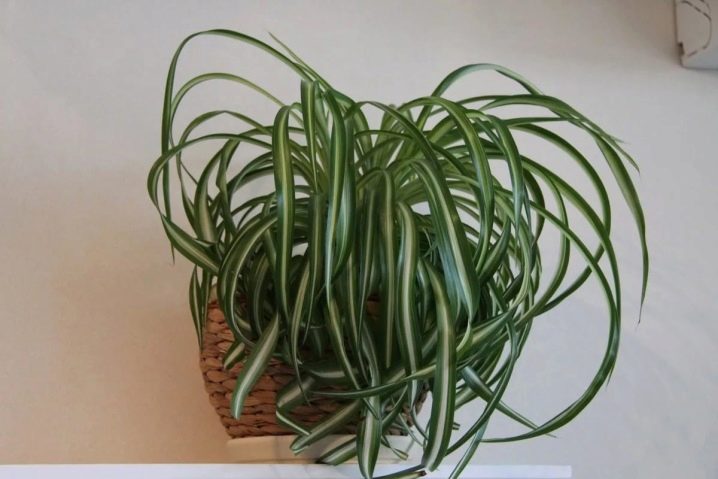
- Ocean - the leaf plates of this variety are not as long as those of others, they are framed with white stripes at the edges;
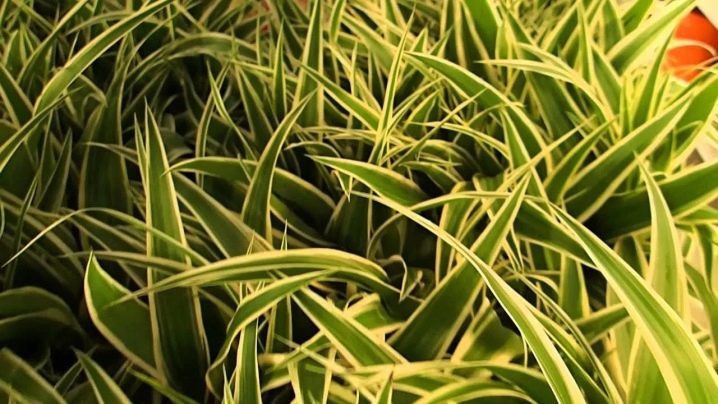
- Maculatum - differs from other varieties in large leaves with yellow stripes;
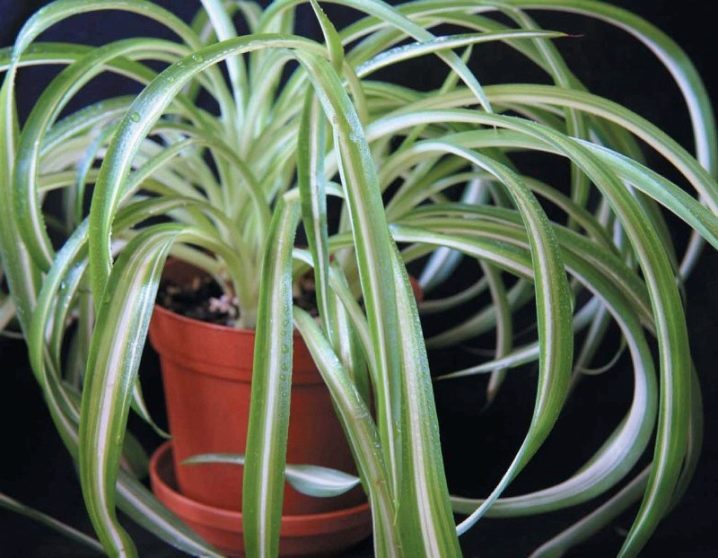
- Curty locks - chlorophytum with wide leaves in a white-green strip, wrapped in spirals.

Home care rules
Chlorophytum is so loved by many flower growers, because it is completely unpretentious in care. In order to always maintain a neat and attractive appearance of a flower, it is enough to observe simple conditions for its maintenance.
- Watering. It is better to water the flower with settled water at room temperature (or slightly cooler) as the soil dries. However, if the flower remains for 1-2 weeks without watering, it will not die. The leaves may turn pale and lose turgor, but after watering, the decorative qualities will be restored. In addition to regular watering, chlorophytum must be sprayed with water at least once every 2 weeks and wipe the leaves from dust with a damp cloth.
You can also wash the flower under a low-pressure shower. Excessive hydration will not harm it.
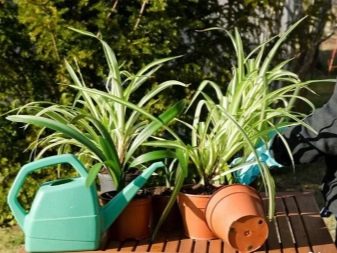
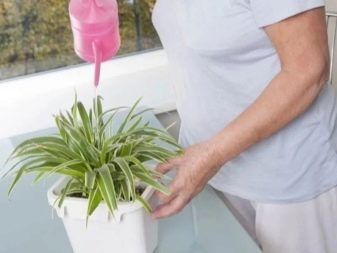
- Lighting. Chlorophytum is classified as a shade-tolerant plant, so it is often placed on cabinets, refrigerators and other places where direct sunlight does not fall. Excessive lighting is harmful for the flower, it leads to wilting and yellowing of the leaves. But if you place a flower on the north-facing windows in an apartment, then it will feel good.
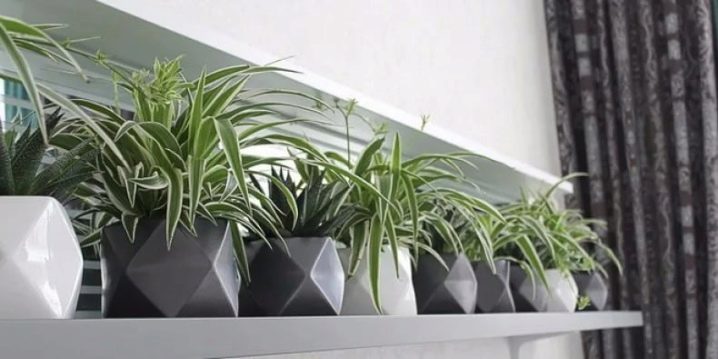
- Temperature conditions. Chlorophytum is not particularly sensitive to room temperature and changes in it. As with many indoor plants, prolonged exposure to temperatures below +16 degrees can be fatal for him. But in general, it has a very wide zone of climatic comfort, and it grows well at temperatures from 20-22 to 30-35 degrees Celsius.
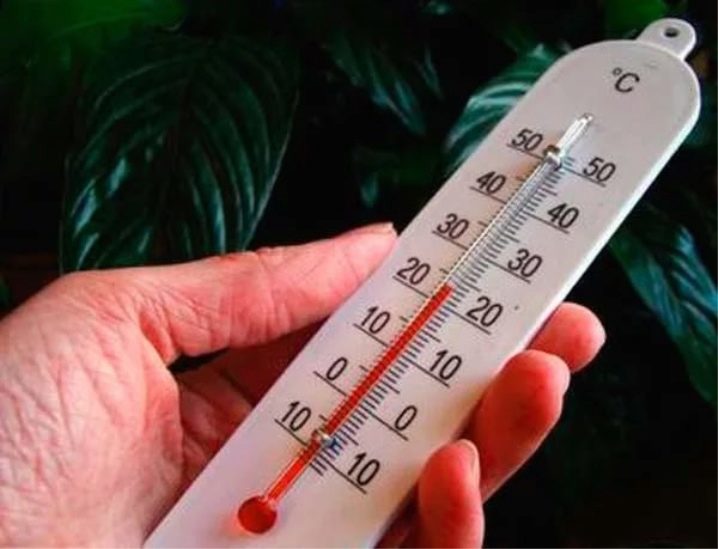
- Soil and fertilizing. This plant is completely unassuming to the soil in its pot. It feels good both in a light substrate with a high sand content and in a soil rich in organic compounds, peat and humus. Chlorophytum is especially insensitive to the acidity indicator, but excessive acidification of the soil can adversely affect its health.
It is enough to feed the flower 1-2 times a year with mineral fertilizers. They should be entered according to the instructions. This is best done between May and September.
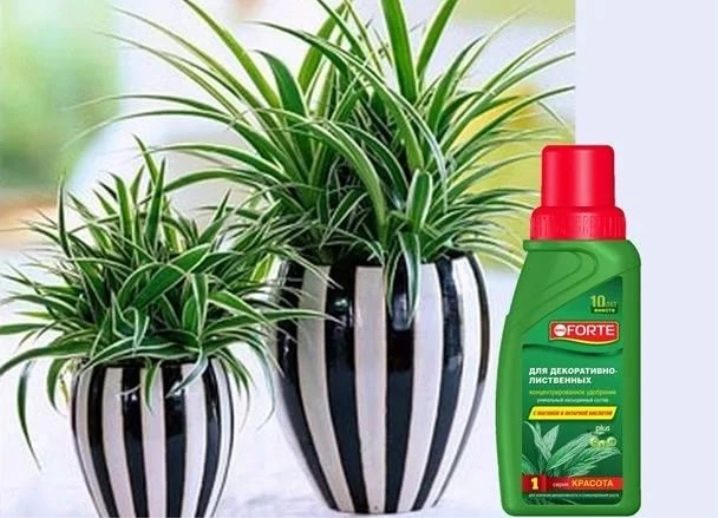
Reproduction
It is possible to propagate chlorophytum in different ways.
- "Children". Chlorophytum mainly reproduces in small bushes that form on air whiskers. Usually these bushes are called "babies". For rooting, it is enough to cut off even a very small "baby" from the air mustache and place it in moist soil. You can put it in water and wait for the appearance of young rhizomes, and then transfer it to the ground.
It is best to jig the "babies" at the end of winter - early spring, before the beginning of the period of active growth of the plant.

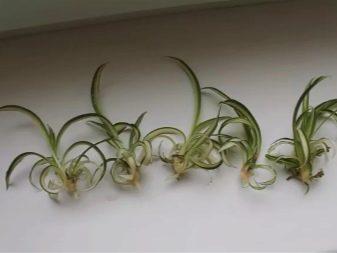
- Seeds. Seed propagation is not very popular among gardeners, since this procedure is troublesome, and the percentage of seed germination is quite low - no more than 30 percent.It is better to plant in spring, when daylight hours are active. For better germination, the seeds are soaked in gauze a day before planting. Sandy-peat soil is prepared in pots, into which the planting material is placed to a depth of 5-7 mm. The soil is moistened and covered with a film.
Before emergence, greenhouses are kept in a slightly darkened place at a temperature of 22-25 degrees Celsius. Crops must be ventilated daily and moistened by spraying so that the seeds do not wash out. After 4-6 weeks, single shoots appear.
Seedlings should be opened gradually, each day increasing the time spent in the light. When 2-3 true leaves appear at the seedlings, they are seated in separate small pots.
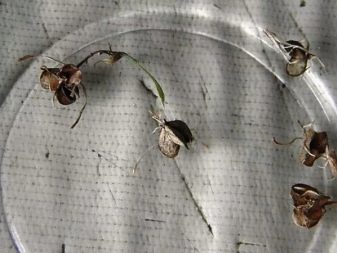
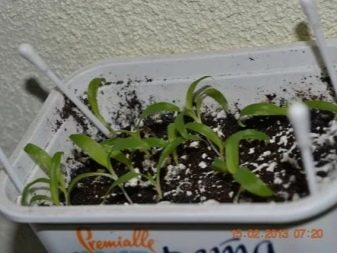
- By dividing the bush. Chlorophytum should be separated during spring transplantation with excessive growth of the rosette of the mother bush. A bush extracted from a pot with a sharp knife is divided into four equal parts, the places of the cuts are sprinkled with charcoal and planted in separate pots.

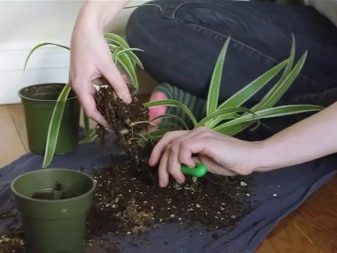
Diseases and pests
Chlorophytum is resistant to most diseases and pathogenic insects affecting indoor plants. However, sometimes the flower loses its decorative qualities and looks sick. This can happen for several reasons.
- Excessive moisture and lack of light. These factors lead to decay of the root system. In this disease, chlorophytum looks wilted, although the soil in the pot is moist. And sometimes brown stripes appear on the leaves in the middle. To save the flower, it needs to be transplanted, while cutting off the decayed roots by treating the cuts with charcoal. After transplanting, the flower should be rearranged to a more illuminated place.
- Dry air, excessive moisture and stagnant water in the sump, or excessive amounts of nitrates in the soil. The flower reports these negative factors with the drying tips of the leaves. To get rid of this, the flower should be transplanted, the soil should be changed to a lighter one, and a container of water should be placed near the pot to humidify the air.
- Lack of light and nutrients. At the same time, in the striped varieties of the flower, fading of the stripes is observed, the color of the leaves becomes faded. In this case, fertilizer should be applied to the soil, and also the place of the flower should be changed to a more sunny one.
- Lack of moisture and dry air. In the hot season, this leads to the fact that the leaves of the plant begin to dry at the roots. It is very simple to get rid of this ailment - to increase the frequency of watering and spraying.
- Excessive lighting. It leads to the formation of brown spots on the leaves. To prevent this from happening, it is enough to rearrange the pot to a more shaded place.
- Rare insects that infect chlorophytum are aphids, nematodes, thrips and mealy worms. You can get rid of them with a folk remedy - gently wipe the leaf plates with a cloth soaked in soapy water, then rinse.

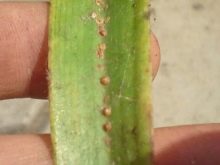

Beneficial features
Chlorophytum is no coincidence one of the most popular houseplants. In addition to excellent decorative qualities, it also has some useful properties.
- Air purification. This flower is more effective than many others in absorbing not only carbon dioxide, but also assimilates carbon monoxide, acetone vapor, formaldehyde and nicotine in its leaves. Therefore, it is highly recommended to keep it in the kitchen and in rooms that are often smoky with tobacco smoke, as well as where there is a lot of chipboard furniture, since it emits formaldehyde in small doses.
- Air humidification. Chlorophytum intensively collects and evaporates moisture, therefore it is a natural humidifier. It is very beneficial for people with various lung conditions and for keeping skin youthful. According to statistics, one flower humidifies the air in an area of 2 square meters around it.
- "Family happiness". According to Feng Shui, it is good to keep this flower in the house to maintain a calm family atmosphere and bring harmony to personal life.
- Good for pets. Owners of cats and small dogs sometimes grow chlorophytum for their pets, as this flower helps to cleanse the stomach, is absolutely harmless to them, and also contains some useful vitamins.
For the beneficial properties, care and reproduction of chloroite, see below.





























Very helpful article. Thanks!
Thanks. It was interesting.
The comment was sent successfully.